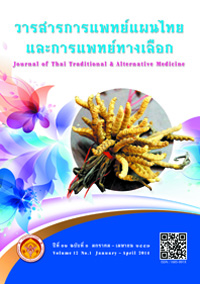Floristic Diversity, Conservation Status and Distribution of Medicinal Plants in Phu Phan forest complex: Northeastern Thailand
Main Article Content
Abstract
The objectives of this study were to analyze the species diversity of medicinal plants as well as their distribution and conservation status in Phu Phan forests, Northeastern Thailand based on the LBSDC Project. The project conducted by MNRE from July 2006 to January 2009, covering a sample of 49 plots in 4 provinces. As a result, the Thai Medicinal Plants has been covered 429 species belonging to 102 families; among them, 64 species are in the family Leguminosae. The top five dominant species with a high Important Value Index (IVI) were Shorea obtusa Wall., S. siamensis Miq., Dipterocarpus obtusifolius Teijsm.ex Miq, Xylia xylocarpa Taub. var. kerrii Nielsen and Pterocarpus macrocarpus Kurz. Shannon-Wiener species Index (H’), Species Diversity (D) and Evenness Index (J) were 3.84, 46.42, and 0.74 respectively. Of all the 50 species, 16 were classified into Red List species. The results of this study can be used as depth information for developing other tools for further planning and management of medicinal plants including their native forests in other regions of Thailand.
Article Details
References
2. Orr D. (1991). What is education for? [cited 2011 June 4]. Available from: https://www.context.org/ ICLIB/IC27/Orr.htm
3. สำนักงานปลัดกระทรวงทรัพยากรธรรมชาติและสิ่งแวดล้อม. รายงานฉบับสมบูรณ์โครงการสำรวจรวบรวมข้อมูลความหลากหลายทางชีวภาพระดับท้องถิ่น ปี 2550 พื้นที่จังหวัดอำนาญเจริญ. กรุงเทพฯ: กระทรวงทรัพยากรธรรมชาติและสิ่งแวดล้อม;2551. (476 หน้า).
4. Napompeth B. Current status of biosafety policy and regulation in Thailand. Paper present at Bio-Asia workshop 2000. Hangzhou, China November 27-30, 2000.
5. Pasa AE. Biodiversity study of a smallholder-protected forest ecosystem in Leyte, Philippines. Biodiversity 2011:12(1);38-45.
6. ธวัชชัย สันติสุข. ป่าของประเทศไทย. กรุงเทพฯ: สำนักหอพรรณไม้ กรมอุทยานแห่งชาติ สัตว์ป่า และพันธุ์พืช; 2549. (120 หน้า).
7. นิวัต เรืองพานิช. ป่าและการป่าไม้ในประเทศไทย. กรุงเทพฯ: ศูนย์ส่งเสริมวิชาการ; 2548. (476 หน้า).
8. กรมป่าไม้. แผนงานตรวจสอบผลการแปลตีความข้อมูลจากภาพดาวเทียม โครงการจัดทำแผนที่ป่าไม้ระบบมาตรฐาน. กรุงเทพฯ: ส่วนวิเคราะห์ทรัพยากรป่าไม้สำนักงานวิชาการป่าไม้ กรมป่าไม้; 2544ก.
9. Pooma R., Suddee S., Chamchumroon V., Koonkhunthod N., Phattarahirankanok K., Sirimongkol S., Poopath M., editors. A Preliminary Check-list of Threatened Plants in Thailand. Bangkok: National Park, Wildlife and Plant Conservation Department; 2005. (196p).
15. Krebs CJ. Ecological Methodology. 2nd Ed. Addison-Welsey Educational Publishers, Inc.; 1999. (624 pp.).
16. Pielou EC. The measurement of diversity in different types of biological collections. J theor Biol 1996:13;131-41
18. The Plant List a working list of all known plant species,2010. çThe Plant List 2010é. [Online]. 2013 [cited 7 November 2013]; Available from: https://www.theplantlist.org/
20. Santisuk T. Status from Thailand red data: plants. Bangkok: Office of Natural Resources and Environmental Policy and Planning; 2006. (256 p.).
21. International Union for Conservation of Nature and Natural Resources, 2009. çRed List of Threatened Species". [Online]. 2009 [cited 26 March 2011]; Available from: https://www.iucnredlist.org/news/iucn-red-list-site-made-easyguide
25. Samek JH., Skole DL., Klinhom U, Butthep C, Navanugraha C, Uttaruk P, and Laosuwan T. Inpang Carbon Bank in Northeast Thailand: A Community Effort in Carbon Trading from Agroforestry Projects. In Kumar B.M. and Nair P.K.R. (eds.), Carbon Sequestration Potential of Agroforestry Systems: Opportunities and Challenges, Advances in Agroforestry 8, CA: Springer Science+Business Media; 2011. p. 263-80.
29. Zhang Y-B and Ma K-P. Geographic distribution patterns and status assessment of threatened plants in China. Biodivers Conserv 2008;17:1783-98.

